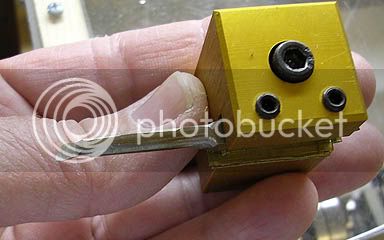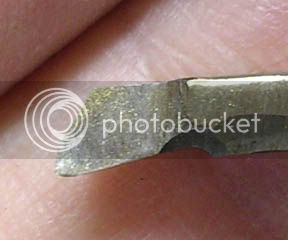My saw is going again now, I found a bad connection on one of the phases so sometimes it was only running on two phase. So well done Swarf Rat you were spot on with you diagnoses.
Well my build has progresses a bit further making all the round parts.
I made the bush a press fit into the frame.
In model flying we have a term hanger rash, which is damage done to an airframe when a model it is not being flown. Is there an equivalent for parts getting scratched or marked after they are finished? If there is then this little brass bush suffered twice! First off when I pushed it into the hole a small piece of swarf scratched as it emerged through the frame. Then later on in the build when I decided to place it to one side rather than mount it centrally in the frame to give more room for the grub screw in the crank wheel, I managed to push it into a square 3/8 socket drive hole, when I needed a shroud around the part so I could press it back through the frame with the vice.
Here we are pre square 3/8 broach marks. (So later on when you see the assembled engine they are not 4 jaw marks.) The axle is still to be cut to final length
The axle is made from silver steel. It's stock form it was 6.33mm. I currently only have metric drills in 0.1 mm steps up to 6mm. Then I have 0.5mm steps. Well a quick test of 6.33mm axle in a 6.5mm hole gave too much slop so I decided to cut the axle down 5.8 mm so I had some leaway to make free and interference fits of the crank wheel and the flywheel.
I found that it's tough stuff to machine. Being thin I had similar spring issue to making the valve part.
Axel done. Next step was to tackle the fly wheel. I had a suitable piece of ali stock for the part. I put it in the chuck and faced the end, drilled the center hole and clean up the circumference, added the bevels. Everything was going well until I started to part it off. Even though I had the chuck done up tight and plenty of ali to grip, the parting tool cutting caused the part to shift in the chuck so it went out of true. I re-trued by refacing it but then the hole on the center was now not exactly in the center. So once I had finished it I mounted to on the axle as an arbor and trued it up again taking very light cuts. I think I got away with it, next time I will drill the hole last.
With hindsight I think maybe I should of cleaned up the end of the stock and then put that end in the chuck so it could get a better grip? The stock did look nice and round but I guess it wasn't perfect.
Anyway here we are about to clean up the parted face. I'm using a lemonade can kindly donated by one of our hoilday cottage guest's in their recycling bin to stop the chuck marking the part, one of my glass beer bottles wouldn't do the trick! I used the dial gauge on the shamfered rim to make sure the part was running true. As there was not much part to grip I took very light cuts using the cross slide self feed. It gave a nice finish (see below).
Here is the crank side of the engine. The crank wheel is also silver steel. I found it too hard for my parting tool to cut so parted it with the band saw and then put it back in the lathe to clean it up. It fits to the shaft with a 3mm grub screw. Why silver steel, well it was the only 1 inch round stock I had.
The finished axle assembly. Piston and valve in their correct position for a change.
And finally a view of the Flywheel and the rhs of the engine.
So just the crank and valve rods and their spacers to make and we are ready for a test run. I might build a set in steel first to protype the engine and prove the valve timing and then re make them in brass to give better aesthetics.
The end is in sight. Hope she runs.
Nick




























